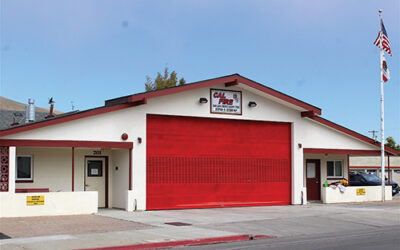Like most every other aspect of the City of Morro Bay’s Water Reclamation Facility Project, the costs for managing the City’s largest public works project ever, has jumped considerably from initial projections.
The City Council approved the fourth amendment to its contract with Carollo Engineers for program management services and like the other three amendments, the costs and services have greatly increased but still not high enough to force the City into another rate increase.
“When initially hired in April 2018,” reads the June 22 Council staff report, “Carollo provided an estimate of $7.64 Million for the entirety of the program management effort [anticipated end date in Fiscal Year 2022/23] for Carollo and their known sub-consultants and scope at that time.
“During the development of Amendment No. 2 in November 2019, Carollo revised the total program management projection to $9.7 Million. During the Project budget reconciliation completed at the end of Quarter 3, FY 2019/20, the estimate at completion for Carollo was $9.8 Million. It is now anticipated to be $12.4 Million.
“None of those estimates would require an increase in the rates paid by the City’s water and wastewater customers.”
This fourth amendment of the contract actually brings the total to $11.99 million, so there would seem to be an anticipated fifth amendment with next year’s budget that would bring the contract up to the $12.4M.
“Like Amendment No. 4,” the report said, “all future amendments [budget allocations] will be developed with staff and brought to the City Council for review and approval through the annual budget process.”
Carollo’s management contract also includes overseeing the public outreach efforts, done through a sub-contractor, that are especially important now with the traffic controls on the Quintana Road business district, where the conveyance system is under construction.
They also oversee the archeological monitoring work, done by another consultant, as part of their management contract. This could also prove problematic as the project is going to trench right through known Native American archeological areas.
The project is supposed to be 90% complete by the end of the current fiscal year (June 30, 2022) with Carollo “supporting stakeholder meetings, project controls, public outreach, and permitting support. Construction of the Conveyance Facilities commenced in Q3 FY 2020/21 and the program manager is providing construction management services for that element of the project as well as archeological investigations and oversight for compliance with cultural resource monitoring requirements.”
The City anticipates the conveyance system, which includes four new pipes being installed to bring the sewage to the new treatment plant off South Bay Boulevard, some 3.5 miles, and back again.
The bundle of pipes include two raw sewage main lines; a water return line to the old plant on Atascadero Road for discharging unusable wastewater into Estero Bay; and, a water line that will carry the highly treated wastewater back to a site on the power plant property where it will be injected into the ground for reuse and as a buffer to prevent seawater intrusion in the Morro Creek drinking water aquifer.
“The program manager,” the City report continued, “has continued hydrogeological analyses, design, and permitting responsibilities related to the potable reuse system [injection wells]. These efforts as well as the installation of the pilot injection and monitoring well system will continue through FY 2021/22. Lastly, the program manager will execute a number of tasks related to the City’s potable reuse and pretreatment ordinance requirements.”
So the program management contract has now jumped from the initial $7.6M to $12.4M, just as the contract with Filanc/Black and Veatch, to construct the treatment plant jumped some several million after a landslide at the plant site in May 2020, plus delays dealing with federal red tape; and the conveyance system contract, initially estimated at $26M by the City, was awarded to Anvil Const., for $31M.
The City also spent some $250,000 in attorney fees on a lawsuit against Vistra, which owns the power plant, in an eminent domain action seeking to force the company to grant utility easements for the WRF. Vistra had claimed the easements were worth $6 million.
A judge was to essentially set the price but the two sides settled for $1, with the City relinquishing a claim that it could buy the plant property for $1 in 2033 if it wasn’t producing energy. Vistra committed to tearing down the old power plant by 2028, or pay the City $3 million.
The City also agreed to cooperate with Vistra’s efforts to build the world’s largest lithium-ion battery storage facility at the power plant, another highly controversial project.
The City made no promises to approve the battery project, the application for which is now being reviewed by the planning department for completeness. It must undergo a full environmental impact review plus numerous public hearings that are likely to end up at the Coastal Commission in any event.
As part of a complex financing scheme, the City received a “Water Infrastructure & Funding Innovation Act” (WIFIA) loan from the Federal Environmental Protection Agency for $62M at 0.85% interest, and so far, the savings in interest payments, some $29M over the loan’s lifetime, is such that despite the cost increases, the City has not had to ask water-sewer customers for a rate increase.
And the overall project costs now top $144 million.
In July 2018, when ratepayers were asked to approve rate hikes that added a $41 a month surcharge to their bills (which had already been raised to pay for a previous, abandoned project), the total costs were listed at $126M.
City Manager Scott Collins said the $144 million figure, “is based on updated projections for the conveyance system — more monitoring and dealing with delays from outside agencies. That number also includes several million in contingencies.”
The City also has millions in cash available for the project, as the rates were set anticipating the City having to dole out over $25 million to cover any gaps in the loan financing.
The City has been covering previous cost increases by biting into the healthy contingency that was built into the rate hikes. That coupled with the interest savings, has allowed the City to absorb increases without another rate hike.
Such rate increases are subject to a protest vote process under the State’s Proposition 218. If over 50% of the property owners (or whomever pays the water/sewer bills), votes “No” to a proposed rate hike, the City cannot enact it.
This rarely happens with Prop. 218 votes, however, significant displeasure with the project among residents has grown greatly since construction started, and getting another rate hike for this project could prove difficult.


